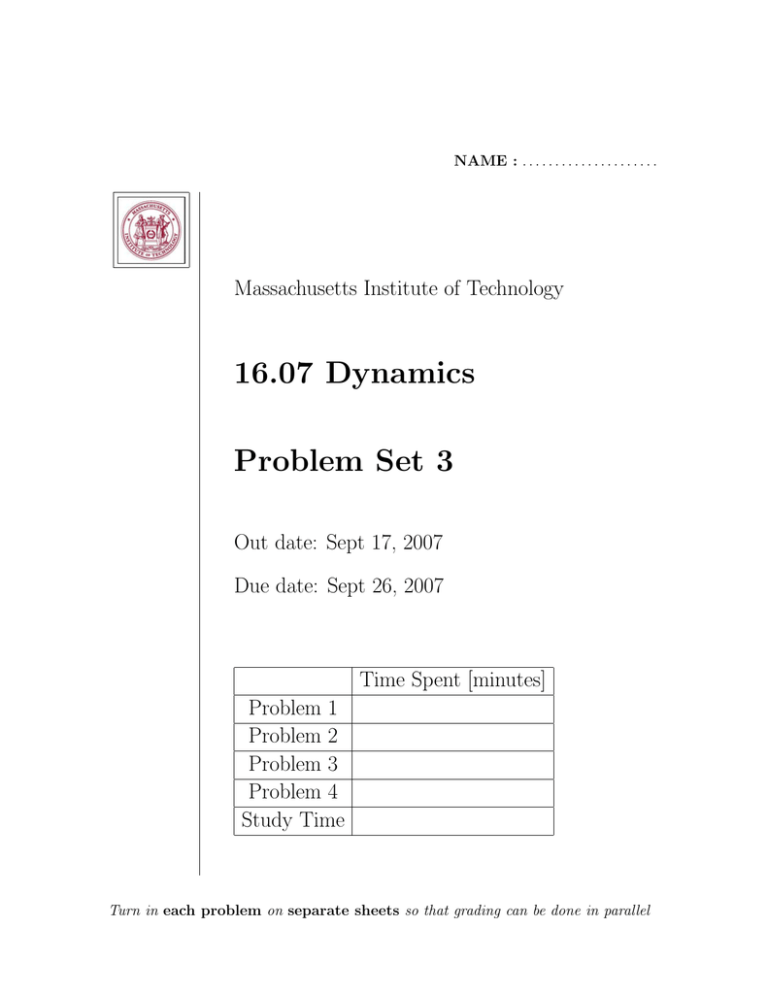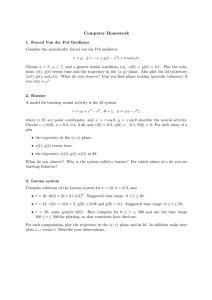Document 13352606
advertisement

NAME : . . . . . . . . . . . . . . . . . . . . . Massachusetts Institute of Technology 16.07 Dynamics Problem Set 3 Out date: Sept 17, 2007 Due date: Sept 26, 2007 Time Spent [minutes] Problem 1 Problem 2 Problem 3 Problem 4 Study Time Turn in each problem on separate sheets so that grading can be done in parallel Problem 1 (10 points) The large wheel of the quick-return mechanism rotates in the counterclockwise direction at a constant speed of 60 rpm (revolutions per minute). There is a “collar” at radius R on the wheel which positions the lever of length L which is free to slide through the collar. a) How many degrees of freedom does this system have? b) What is the relationship between the angle θ of the rotating wheel and the angle β between the lever and the horizontal? c) Determine the s, ṡ and s̈ as well as the velocity and acceleration of point P as a function of θ. d) Determine numerical values when θ = 45o . Use R = 1 m, h = 1.5 m and L = 3 m. e) Calculate also the time it takes for the long bar to do i) the advance movement (rightmost position to the leftmost position) and ii) the return movement (left­ most position to rightmost position). (Hint: at what angle θ does it reverse direction?) Problem 2 (10 points) Part A A vehicle moves at constant altitude y0 . At time t = 0 it is located at x = 0, at which time it begins to accelerate in the x direction at a constant rate ax from an initial velocity v0 at x = 0. Describe the motion in polar coordinates, r, θ as shown. We are going to express the acceleration in polar coordinates. Work out the various terms: 1) Show that ṙ = v(t) ∗ x(t)/r(t) 2) Show that θ̇ = −v(t) ∗ y0 /(r(t))2 3) Show that r̈ = (v(t)2 ∗ y02 + ax ∗ x(t) ∗ r(t)2 )/r(t)3 4) Show that θ¨ = y0 ∗ (2 ∗ v(t)2 ∗ x(t) − ax r(t)2 )/r(t)4 From these expressions form the acceleration vector a = ar er + aθ eθ . Say something interesting about the acceleration vector. Part B Repeat the problem using cartesian coordinates. Which do you prefer? Problem 3 (10 points) Part A Three blocks are positioned as shown in the figure resting on a frictionless plane and a force F is applied to one of the blocks as shown. The coefficient of friction between any two surfaces of the blocks is µ. Take as a model for friction that the friction force is of a magnitude to support the motion (mutual acceleration) of the blocks, but that it is limited to a maximum value of µ ∗ FN where FN is the normal force between the surfaces. When this limit is reached, the surfaces begin to slip with an internal force µ ∗ FN acting between them. Answer the following questions: a) What is the maximum force which can be applied without m3 slipping over m2 ? b) For the force calculated in a) what is the contact force between m1 and m2 ? c) Take m1 = m2 = m3 = 1 . Now consider that the force F increases linearly with time F(t) = 2 ∗ t. Take the friction coefficient µ = .3. Calculate and sketch x(t), v(t) and a(t) for mass2 (and be sure to get out of the way). Take the length of block 3 as 2m. and the length of the gap as 1m. Stop the problem when the center of mass of the upper block reaches the edge of block 2, i.e. a slip of 1m. Problem 4 (10 points) (MATLAB exercise) MATLAB problem philosophy: treat this problem like any other homework problem, but use MATLAB as a means to understand the problem and run cases. Your writeup should discuss the questions asked and interpret the results obtained using MATLAB as a means to generate the results. Include graphs of numerical results as called for in the problem statement. You need not include your code in the writeup, but you must submit your code on line. We are going to consider the reentry of a vehicle through the atmosphere. (Having tried this problem myself, I know that typical numerical methods go crazy when encountering the very large derivatives that can occur in this problem if the reentry angle is too steep. Therefore, we are going to sneak up on this problem. That is the reason why the problem has so many parts; in the end it will save you time.) A reasonable fit to the density of the atmosphere is ρ(y) = 1.225kg/m3 e−y/7000m (1) We are going to consider several different models for reentry, moving from the simple to the more complex. Use the formula developed in class for the drag force on a particle to compute the force along the particle trajectory. The only aerodynamic force considered will be drag, the aerodynamic force aligned with the instantaneous velocity vector. We will consider the earth as a flat plane. Take the initial altitude as y0 = 100, 000m and V0 =6000 m/sec after the vehicle fires its retro-rockets. (6000 m/sec is below orbital velocity.) Ballistic coefficient was defined in Lecture 2 as B = CD A m (2) a) For this part, ignore gravity (and centrifugal acceleration). In this case, the particle trajectory will be a straight line because there are no forces normal to the trajectory. Formulate the differential equation for position s(t) along a straight-line trajectory. For a Ballistic Coefficient B=.0001, plot a(t) vs. t for 3 angles θ (say from 2 to 10 degrees) that the trajectory makes with the horizontal. (No need to turn these plots in; see below for deliverables.) Determine θ to the nearest degree in order that the acceleration felt by the astronauts is less than but close to 9 g’s. Plot V(t) and a(t) for this θ. How far does the vehicle travel in the x direction; how long does it take? b) Now to get ready to do the more general case. Formulate the equations as general trajectory equations for x(t) and y(t). If all forces but drag are ignore, the result will be the same straight-line trajectory as obtained in part a). Plot y(t) vs. x(t) to visualize the trajectory. Plot the magnitude of both the velocity vector V� (t) and the acceleration vector �a(t) vs. t. You should get the same results as Part a). Plot the trajectory y(t) vs. x(t). c) Now consider gravity: turn gravity on in the y(t) equation. Continue using θ obtained from part a). Plot the magnitude of both V� (t) and �a(t) as before; interpret your results. What happens to the magnitude of a(t)? Why? How far does the vehicle go? When does it hit the ground? d) Space vehicles in orbit are in equilibrium with a force balance between gravity and centrifugal force (we will talk more about this later). The centrifugal force does not immediately turn off when the vehicle begins reentry. Include an upward vertical force F = V 2 /R. Because the trajectory is so flat, and the altitude is so small compared to the radius of the earth, you may use only the horizontal component of velocity u for V� and the constant radius of the earth R = 6378 ∗ 103 m for R. How are your results changed. Deliverables: 1. a) θ to the nearest degree that keeps the magnitude of a(t) less than but close to 9 g’s. Plot a(t) and V (t) for that θ. 2. b, c, d) For the b, c and d cases, plot the trajectory y(t) vs x(t); plot the magnitude of V (t) and a(t) vs t. Read off the distance traveled in x. Determine the time of impact. MIT OpenCourseWare http://ocw.mit.edu 16.07 Dynamics Fall 2009 For information about citing these materials or our Terms of Use, visit: http://ocw.mit.edu/terms.


